|
Overview of and Links to the Pages of My Community: Desert Vision - Succah
D E S E R T V I S I O N
|
(1)
ALT-NEU-LAND 2003 The Midbaryah: |
(2)ALT-NEU-LAND
2003
- Gadi's and Efrat's vision "The first Midbaryah does already exist: Mitzpe-Ramon and its surroundings!" |
(3) ALT-NEU-LAND 2003 The Pyramidion or Ohalah or Rihlah |
|
+ 2003 Sculpture never completed ; ~~~ 2009 Sculpture completed on July 27, 2009 |
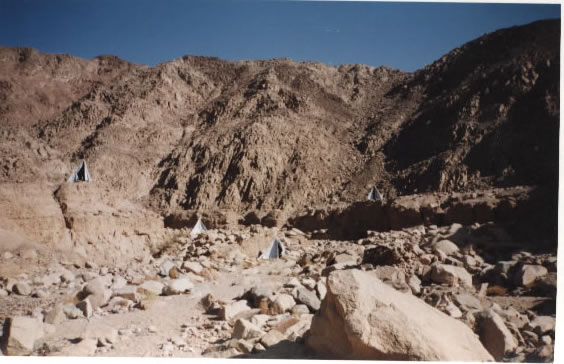
2003_02_19 ; last update:
2003_02_20
I do not die, as much as I would prefer it often.
But neither has my vision for 2003 come true.
The little book hints at yet another "Gulf-War",
and the fulfillment of this is all too imminent .
But the future desert economy
will not be based on succah-like
structures,
which are - after all - too permanent,
with all the temptations for people to "settle" and "sell/buy"
or "bequeathe/inherit"
which implies expansion and the destruction of the very basis of Desert economy:
the resource of Space-Purity-Silence.
This future has been preparing itself since long.
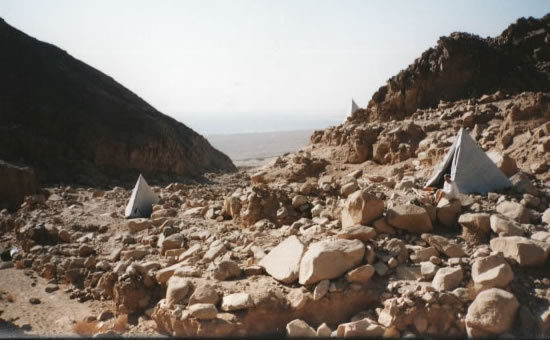
The economic future will be in mobile
hosting-enterprises,
based on 12 pyramidal tents and a team of three owners!!
I intend - one day - to outline the technical and financial viability of this
model.
In Hebrew it would be called "Ohalah", from the word "ohel",
tent.
In Arabic it would be called "Rihlah", a joke of a Bedouin woman
in Sinai,
who associated my name with the Arabic word for "travel/journey/passage".
The English term "Pyramidion" was invented for my model in Sinai
in the summer of 1996,
by Ruth Rosenzweig, my ex-daughter-in-law and Tomer's
mother.
Though each mobile business will be independent,
there
will be close ties between at least two Ohalahs,
like one in the Israeli desert and the other in the Palestinian desert,
They, for instance, would exchange hosts over weekends,
so as to guarantee constant cross-fertilization and renewal.

but in the exterior world - more experimenting was to follow,
the last stage having been with Samira's family in the Zealots' Valley]
|
2009_07_26 I follow my understanding and new lekh-lekhâ on January 1, 2009, that - after 7 years - I should no longer create new pages on my 2 websites, but intermingle the evidence of new experiences with that on existing pages. Here are five inserts about Rotem's visit with Grandma in July 20-25, 2009 Arad ~~~ Mitzpe-Ramon ~~~ Arad
|
To the west of the Visitor-Center we discovered a structure which I hadn't seen before.
Despite the heat Rotem suggested that we go there.
It was simply an observation point, but sophisticated in its architecture:
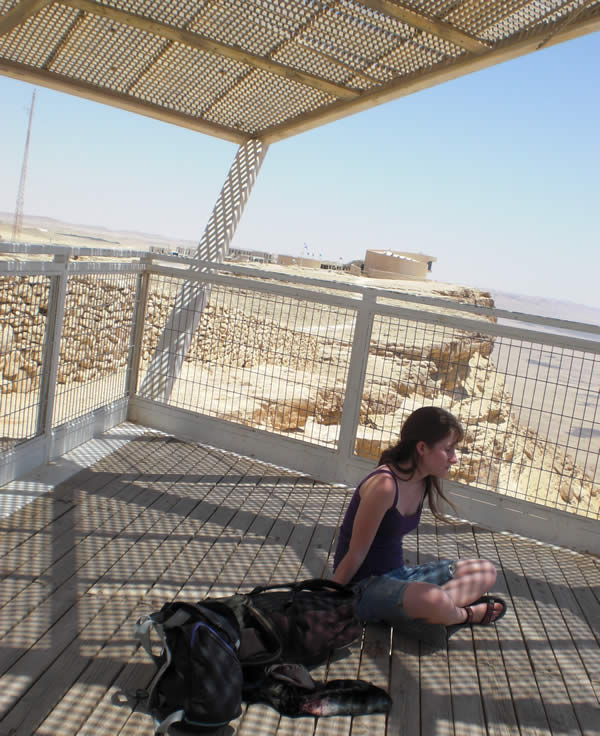
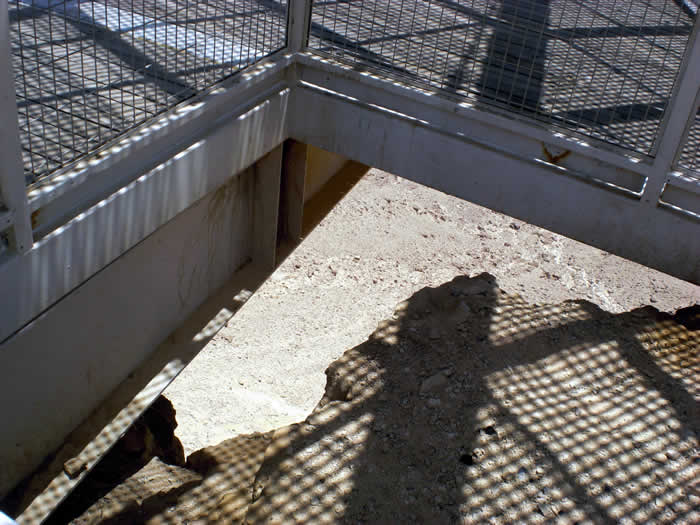
After some other visitors - who disturbed me, especially
one, who did business calls on his mobile phone - had left,
I tried to get some photos, which would convey how impressed I was,
but I couldn't catch the perspective of the abyss underneath the platform...
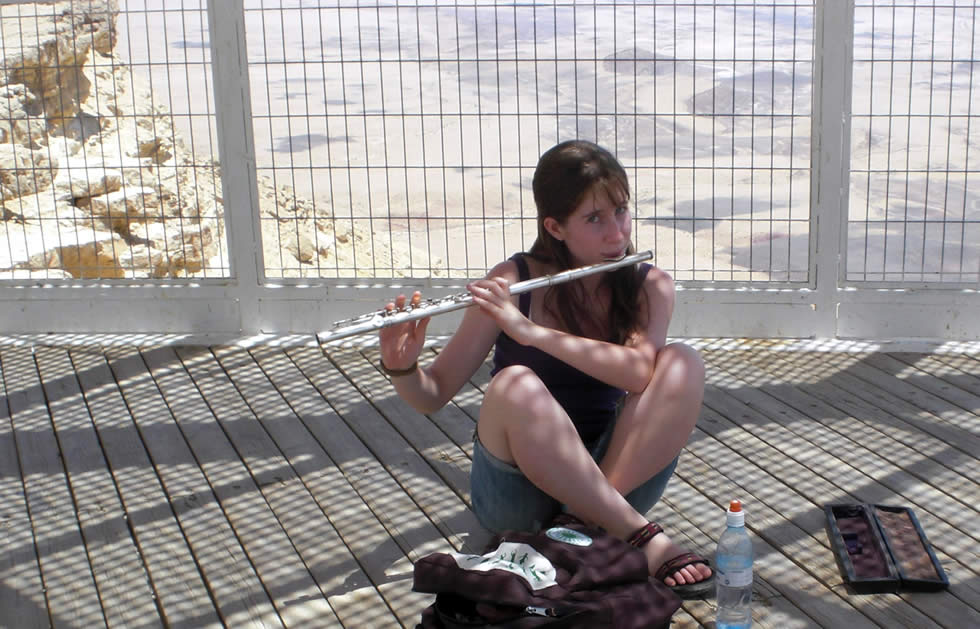
On the other hand - Rotem enhanced the beauty by suddenly taking out my/her flute...
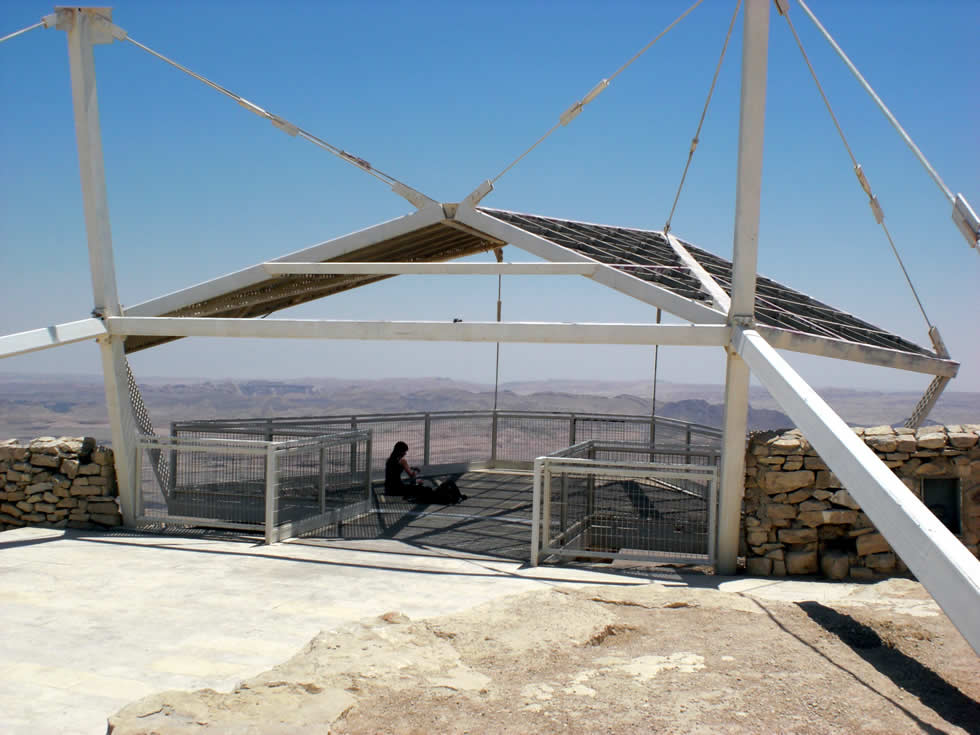
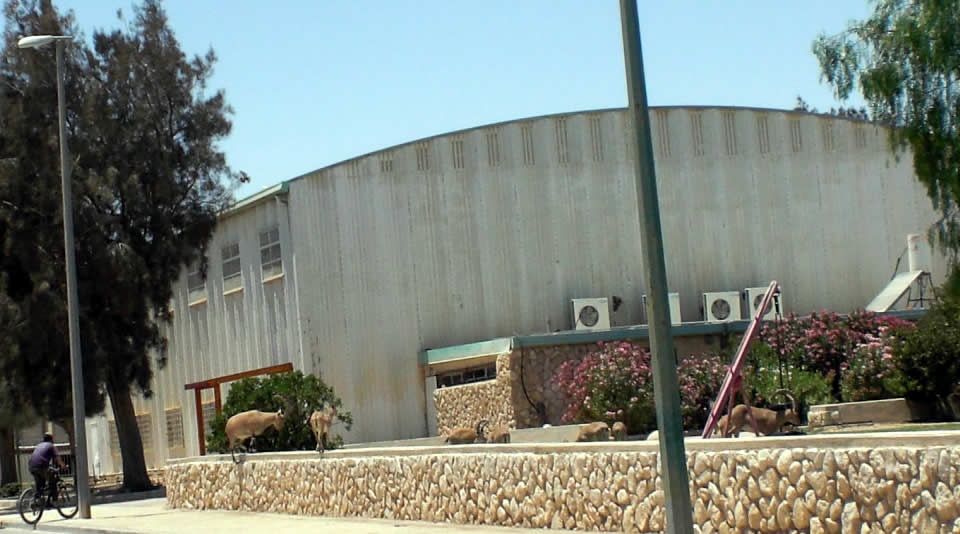
We moved on to the road which runs along the edge of the
Crater
and met these beautiful gazelles - next to what we soon identified as a
"Yeshivah"...
The biker with his kippah
and tzitzis seemed to
be headed there.
We would soon find out, how "religious" Mitzpe-Ramon had become....
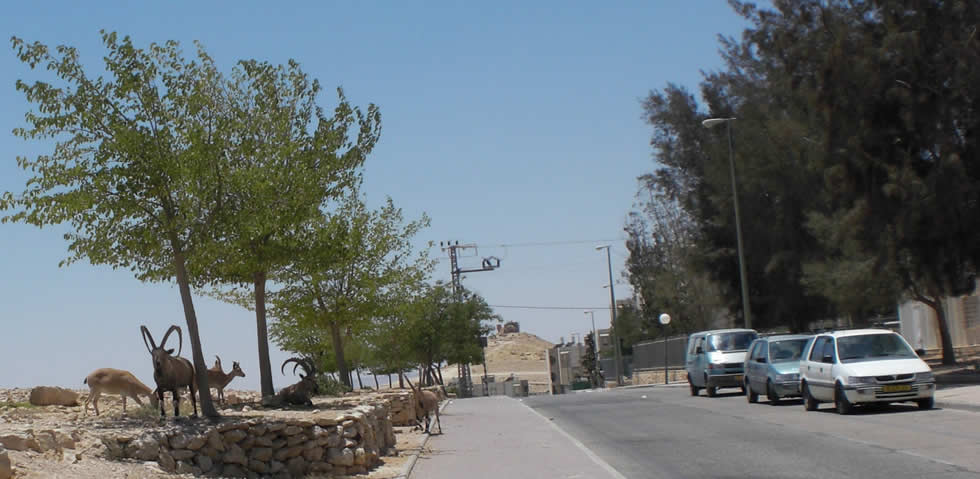
As of now we enjoyed the gazelles - with the Camel-Mountain
across,
as if the road would lead right up to it.
But of course there is a deep wadi in between.
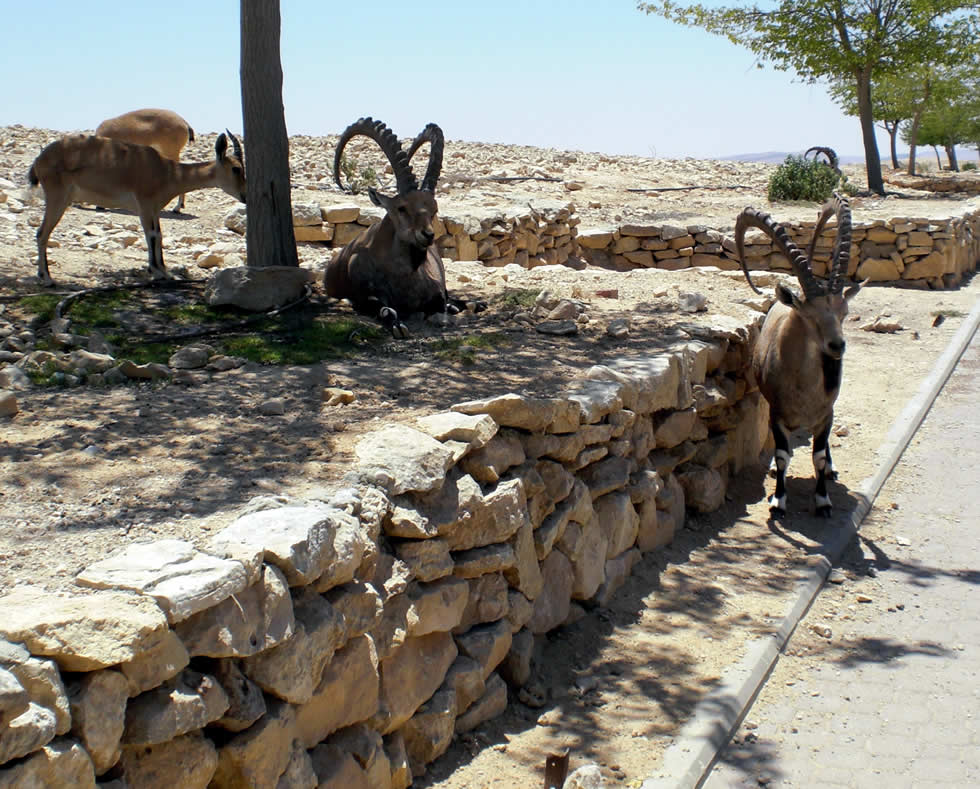
Enjoying shade and casting shadows....
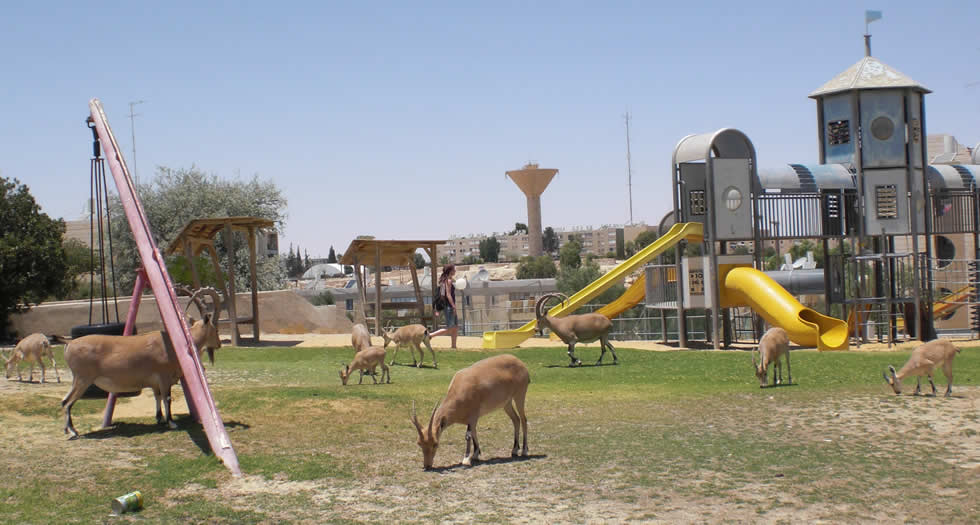
Suddenly they walked over to the playground on the
other side of the street.
I discerned, that more than one playground had been added to the town since
"my time",
and this despite its plight:
At my time there were 6000 inhabitants, now there are only 4000...
as Gadi and Efrat told us with sorrow...
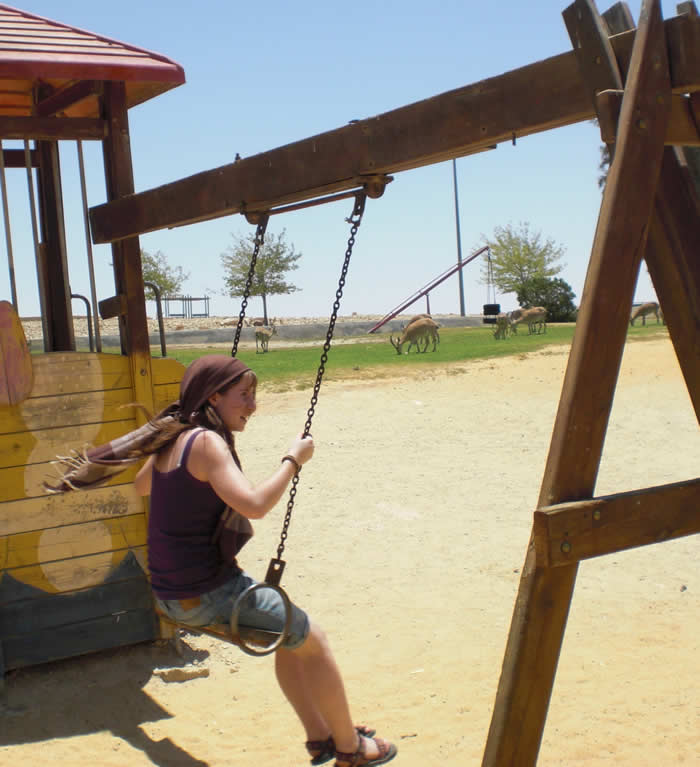
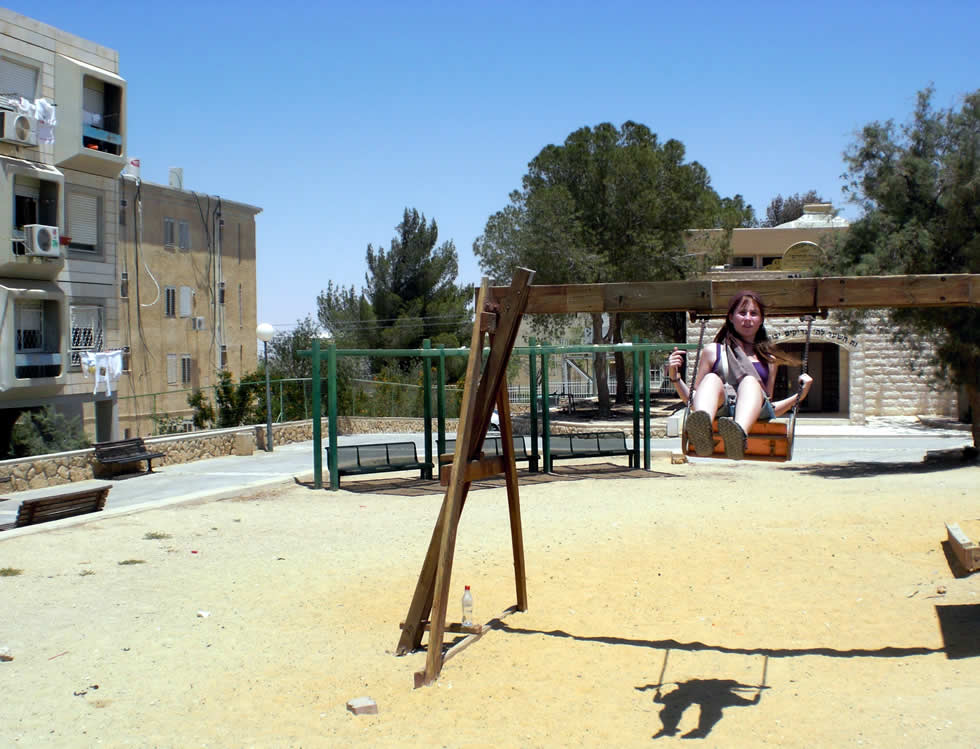
With the swinging Rotem in the center, I am careful
to combine two other spots:
the laundry outside the house and the synagogue "Light
of the Life",
which announces:
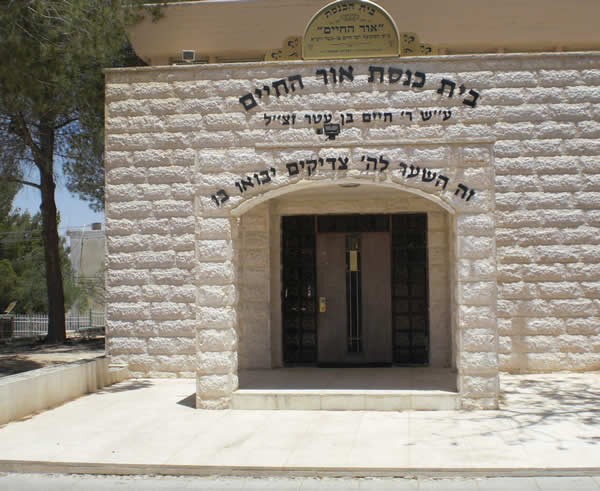
"This is the gate of the LORD; the righteous shall
enter into it. "
(Psalm 118:20)
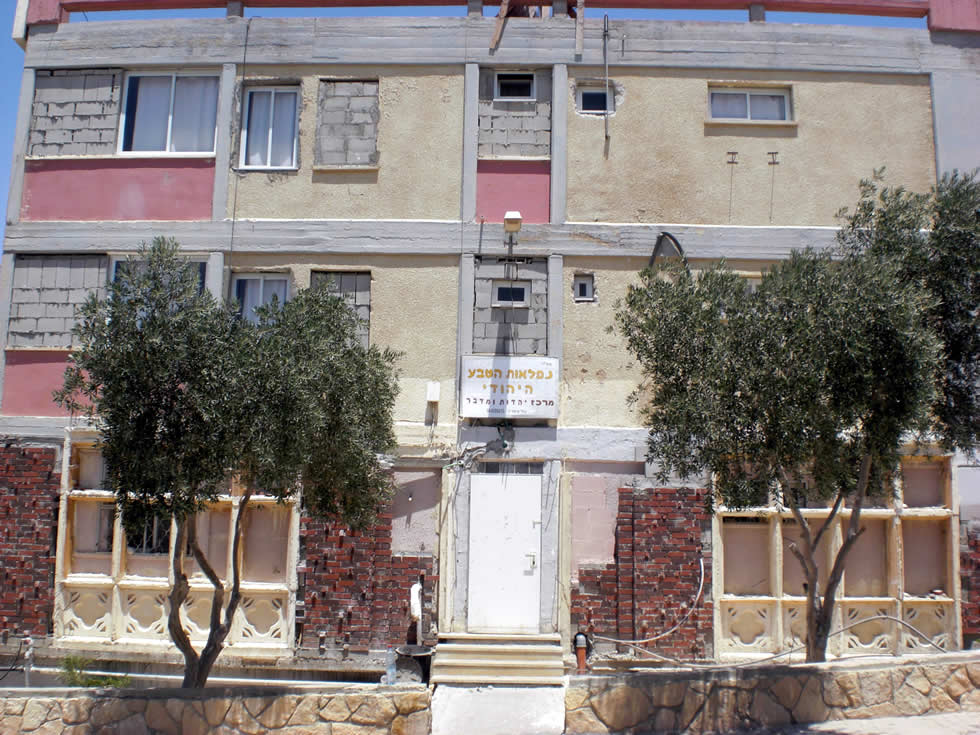
Our aim was to meet Aviel ben-Israel, who was the
leader of the Black Hebrews of Mitzpe-Ramon at my time.
So we turned into a street, which led down to the kiosk where I had spotted
him before.
"Look, savta",
said Rotem suddenly
and pointed to a strange sign on a not very pretty building.

"The
wonders of the Jewish Nature - Center of Judaism and Desert" What the sign said, was so strange, that Rotem suggested to enter and inform ourselves. I remembered that rabbi of my time, who opened a religious highschool at Mitzpe-Ramon, and who was the one who had given me an additional interpretation of the Succot-festival. I also heard, that he brought his pupils to the edge of the Crater for Kabbalat-Shabbat. When I worked on making a 3 1/2 km path from Succah in the Desert to the Alpaca-Farm, so as to demonstrate to everybody, that I wanted cooperation with the people of the farm.... [see images with Rotem's brother Jonathan] the rabbi agreed to let his pupils help me for the first few hours , beginning from the farm. But that rabbi had nothing to do with this American Chabad-House. Gadi had no idea, what had happened to him or to his school. |
In
the Succah "Glossary"
I now discover a link to the
previous page: The "succah" in Jewish tradition is not only a symbol of Wo/Man as a guest in the desert, but also of Wo/Man's creativity and creation, as I was taught by another inventive pioneer in the desert, a rabbi, who founded a new kind of a religious high-school at Mitzpe-Ramon, He said: "The first thing a Jew does, when he comes home from Yom-Kippur (the Day of Atonement, 24 hours of fasting and praying) which is a day beyond Time, is that he hammers the first nails for his family's succah." (The Festival of Succot takes place 4 days later.) |
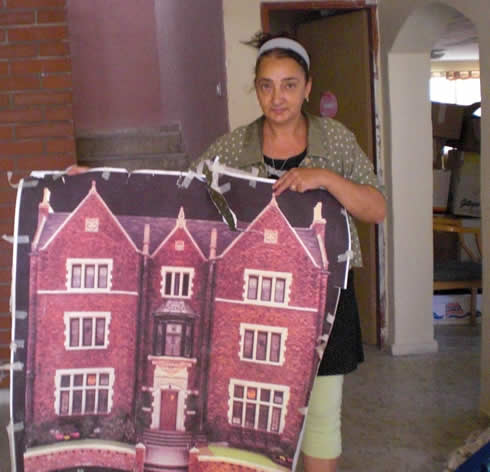 |
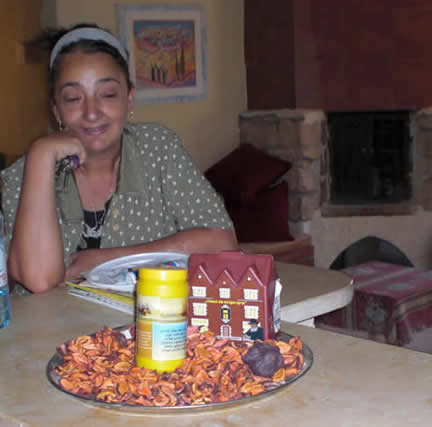 The two French-speaking cleaning women tell us, that this house is to be a replica of "THE HOUSE" of the Chabad Jews in New-York |
Itamar played an important, though ambivalent, part in the history of the Succah since 1990 and until his phone-call in April 2003,
when he asked, if I would manage his Holistic Health Center near Mitzpe-Ramon (planned already in 1990, but never carried out).
In the history of "Noah's Ark" I told
how it was that phonecall from Paris which made me enter one more stage of manifesting
my vision about Peace through Desert Hosting Economy based on the Desert's treasure SPS:
A Vision about Peace between the Desert Nations and between Wo/Man & the Desert Earth )

Some houses further down we finally met Aviel [see
now, Dec. 24, 2010, his intact polygamic family 20 years earlier)
next to his kiosk
(see about the Black Hebrews - Aviel and Yokheved - in Succah-Diary
3 and in Desert Peace Process
3)
We sat with him for at least 2 hours and among 3 customers - also met an
exciting couple from the Alpacca-Farm.
But again - as on the former pages - I do not want to write about the formidable
problems of this community.
I only want to tell the story which was most important for me:
At the end of the first Succah year I had run out of all my money: 30000
$.
That morning I entered the bank - I don't remember what for.
In line stood Aviel.
"How are you",
he asked kindly, in English.
I told him, that I didn't even have money to pay for the fuel of my jeep.
He said:
"Oh, Rachel, that's a very good
place to be ,
the place of not having anything at all."
Since this came from the mouth of one who until recently hadn't even got
a work permit,
I trusted him.
And soon enough, maybe right there on that day in the bank,
I received a gift from my
sister Ursel - may her memory be blessed -
5000 German Marks, worth of perhaps 2500 $ at that time...
Though I had learnt about
the Black Hebrews not only in 1990, when I first met them at Mitzpe-Ramon, but also from my friends in Tel-Arad (in the pages of Walk about Love I several times mention Yeshiya Amariel...) - I now wanted to hear the story first hand, from Aviel. I am comparing what he told to what is written on the Internet about the part of Black Hebrews who moved to Israel. What was different in his story, was this: the first people who came to Israel - after 2 1/2 years in the bush in Liberia, where many became ill and even died - they were welcomed as new immigrants and got all the rights of this category. But soon enough, after about 2 years, citizenship was denied and people were deported back to the US. They reported to their community in Chicago. "But why then did you come in 1973?" I asked. "We simply wanted to come anyway!" Aviel smiled. The Wikipedia article reports, that in 1990 the Black Hebrews received work permits and access to housing and social services. This was exactly in the year, in which I met Aviel. He now told me, what I had totally forgotten: "You invited me with my two sons to come with you to the Succayah and even sleep in one of the Succahs. This was so fantastic, I can never forget it!" |
African
Hebrew Israelites of Jerusalem Ben Ammi Ben Israel established the African Hebrew Israelites of Jerusalem in Chicago, Illinois, in 1966. In 1969, after a sojourn in Liberia, Ben Ammi and about 30 Hebrew Israelites moved to Israel. Over the next 20 years nearly 600 more members left the United States for Israel. As of 2006, about 2,500 Hebrew Israelites live in Dimona and two other towns in the Negev region of Israel, where they are widely referred to as Black Hebrews. In addition, there are Hebrew Israelite communities in several major American cities, including Chicago, St. Louis, and Washington, D.C. The Black Hebrews believe they are descended from members of the Tribe of Judah who were exiled from the Land of Israel after the Romans destroyed the Second Temple in 70 CE.... The Black Hebrews observe Shabbat and biblically-ordained Jewish holidays such as Yom Kippur and Passover. Men wear tzitzit on their African print shirts, women follow the biblical laws concerning menstruation, and newborn boys are circumcised. In accordance with their interpretation of the Bible, the Black Hebrews follow a strictly vegan diet and wear only natural fabrics.Most men have more than one wife, and birth control is not permitted. When the first Black Hebrews arrived in Israel in 1969, they claimed citizenship under the Law of Return, which gives eligible Jews immediate citizenship. The Israeli government ruled in 1973 that the group did not qualify for automatic citizenship, and the Black Hebrews were denied work permits and state benefits. ...No official action was taken to return the Black Hebrews to the United States, but some individual members were deported for working illegally. Some Black Hebrews renounced their American citizenship to try to prevent more deportations. In 1990, Illinois legislators helped negotiate an agreement that resolved the Black Hebrews' legal status in Israel. Members of the group are permitted to work and have access to housing and social services. The Black Hebrews reclaimed their American citizenship and have received aid from the U.S. government that helped them build a school and additional housing. In 2003 the agreement was revised, and the Black Hebrews were granted permanent resident status. In 2009, Elyakim Ben-Israel became the first Black Hebrew to receive Israeli citizenship. The Israeli government said that more Black Hebrews may be granted citizenship. |
|
Continuation of the
photos of Rotem's visit with Grandma in Arad, July 20-25 see in the fourth insert:
|